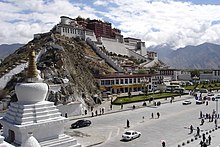
Dalai Lama
Dalai Lama (UK: /ˈdælaɪ ˈlɑːmə/, US: /ˈdɑːlaɪ/;[1][2] Tibetan: ཏཱ་ལའི་བླ་མ་, Wylie: Tā la'i bla ma [táːlɛː láma]) is a title given by the Tibetan people to the foremost spiritual leader of the Gelug or "Yellow Hat" school of Tibetan Buddhism, the newest and most dominant of the four major schools of Tibetan Buddhism.[3] The 14th and incumbent Dalai Lama is Tenzin Gyatso, who lives in exile as a refugee in India. The Dalai Lama is considered to be the successor in a line of tulkus who are believed[2] to be incarnations of Avalokiteśvara,[1] the Bodhisattva of Compassion.[4][5]
For the incumbent Dalai Lama, see 14th Dalai Lama.Dalai Lama
McLeod Ganj, Dharamshala, India
1391
Gendün Drubpa, 1st Dalai Lama, posthumously awarded after 1578.
Since the time of the 5th Dalai Lama in the 17th century, the Dalai Lama has been a symbol of unification of the state of Tibet.[6] The Dalai Lama was an important figure of the Geluk tradition, which was dominant in Central Tibet, but his religious authority went beyond sectarian boundaries, representing Buddhist values and traditions above any specific school.[7] The traditional function of the Dalai Lama as an ecumenical figure has been taken up by the fourteenth Dalai Lama, who has worked to overcome sectarian and other divisions in the exiled community and has become a symbol of Tibetan nationhood for Tibetans both in Tibet and in exile.[8]
From 1642 until 1705 and from 1750 to the 1950s, the Dalai Lamas or their regents headed the Tibetan government (or Ganden Phodrang) in Lhasa, which governed all or most of the Tibetan Plateau with varying degrees of autonomy.[9] This Tibetan government enjoyed the patronage and protection of Mongol kings of the Khoshut and Dzungar Khanates (1642–1720) and then the emperors of the Manchu-led Qing dynasty (1720–1912).[9] In 1913, several Tibetan representatives, including Agvan Dorzhiev, signed a treaty between Tibet and Mongolia, proclaiming mutual recognition and their independence from China. The legitimacy of the treaty and declared independence of Tibet was rejected by both the Republic of China and the People's Republic of China.[10][11] The Dalai Lamas headed the Tibetan government until 1951.
Names[edit]
The name "Dalai Lama" is a combination of the Mongolic word dalai meaning "ocean" or "great" (coming from Mongolian title Dalaiyin qan or Dalaiin khan,[12] translated as Gyatso or rgya-mtsho in Tibetan)[13][14] and the Tibetan word བླ་མ་ (bla-ma) meaning "master, guru".[15][16]
The Dalai Lama is also known in Tibetan as the Rgyal-ba Rin-po-che ("Precious Conqueror")[14] or simply as the Rgyal-ba.[17]: 23
The 1st Dalai Lama was based at Tashi Lhunpo Monastery, which he founded. The Second to the Fifth Dalai Lamas were mainly based at Drepung Monastery outside Lhasa. In 1645, after the unification of Tibet, the Fifth moved to the ruins of a royal fortress or residence on top of Marpori ('Red Mountain') in Lhasa and decided to build a palace on the same site. This ruined palace, called Tritse Marpo, was originally built around 636 AD by the founder of the Tibetan Empire, Songtsen Gampo for his Nepalese wife.[267] Amongst the ruins there was just a small temple left where Tsongkhapa had given a teaching when he arrived in Lhasa in the 1380s.[268]
The Fifth Dalai Lama began construction of the Potala Palace on this site in 1645,[268] carefully incorporating what was left of his predecessor's palace into its structure.[137] From then on and until today, unless on tour or in exile the Dalai Lamas have always spent their winters at the Potala Palace and their summers at the Norbulingka palace and park. Both palaces are in Lhasa and approximately 3 km apart.
Following the failed 1959 Tibetan uprising, the 14th Dalai Lama sought refuge in India. Indian Prime Minister Jawaharlal Nehru allowed in the Dalai Lama and the Tibetan government officials. The Dalai Lama has since lived in exile in McLeod Ganj, in the Kangra district of Himachal Pradesh in northern India, where the Central Tibetan Administration is established. His residence on the Temple Road in McLeod Ganj is called the Dalai Lama Temple and is visited by people from across the globe. Tibetan refugees have constructed and opened many schools and Buddhist temples in Dharamshala.[269]

